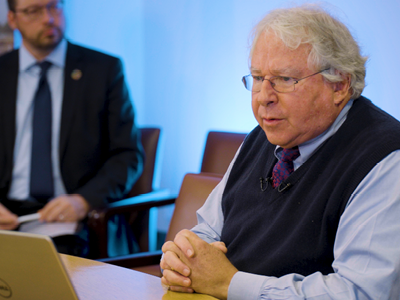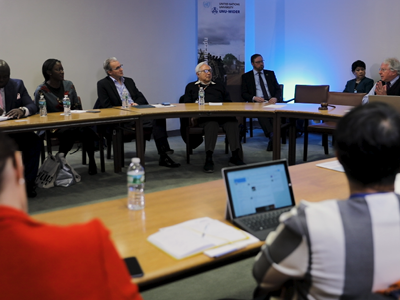Blog
Rethinking African industrialization on another Africa Industrialization Day
This week I attended the 28th Africa Industrialization Day at the United Nations Headquarters in New York. Even sympathetic readers may reasonably ask, why hold another African Industrialization Day at all? The short answer is Africa needs structural change to grow, to create jobs, and to reduce poverty, and the driving force behind structural change has historically been industry. The East Asian miracle was a manufacturing miracle. But Africa has had limited success in industrializing. Today, only about one in five workers leaving agriculture enters the manufacturing sector. In fact, Africa has deindustrialized. As Paul Maseli, the Chair of today’s lecture pointed out, Africa’s share of global manufacturing is smaller today than in 1980.
Three challenges that have stalled industrialization in Africa
I last spoke at the same event in 2015 and noted then that the Brookings Institution and UNU-WIDER were engaged in a research project focused on the question of why there is so little industry in Africa. That research project—Jobs, Structural Change and Industry in Africa—has given us a better understanding of the extent of Africa’s industrialization challenge. Our research shows that three changes in the global economy make industrialization more difficult for Africa.

First, despite some evidence of rising real wages in the region, the success of East Asia as a manufacturing center means that—in contrast to when much of that region broke into global markets—African industry faces a high-productivity, relatively low-wage competitor.
Second, industry has declined as a share of output and employment at all levels of development over the last four decades. This means that African economies may not be able to rely on industry to take the lead in structural change to the extent that East Asian countries could.
Finally, the growth of trade in tasks and global value chains (GVCs) brings both opportunities and challenges. GVCs offer the opportunity to specialize in a limited set of tasks suited to a country’s capabilities, but they place a strong premium on trade logistics, an area in which Africa’s economies have not excelled.
Looking at these trends, Nobel Laureate Joseph Stiglitz has argued that ‘manufacturing is a victim of its own success: productivity growth exceeds the rate of increase in demand… [and thus] it is unlikely that manufacturing export-led growth will have the impact that it had in China and East Asia.’ If manufacturing does not take the lead, what will drive structural change in Africa?
Beyond traditional models of industrialization – or, industries without smokestacks
Here, our research offers some promising insights. Changes in technology and declining transport costs have spawned a growing number of tradable services and agri-businesses—including horticulture—that share many characteristics with manufacturing. They have high productivity and can absorb large numbers of moderately skilled workers. Like manufacturing, they benefit from productivity growth, and scale and agglomeration economies. These are ‘industries without smokestacks’, and we believe that they can play the role in structural change once thought exclusively reserved for manufacturing.
Industries without smokestacks are among the most dynamic sectors of Africa’s economies. High-valued agricultural exports account for an increasing share of Africa’s overall exports. Ethiopia, Ghana, Senegal, and South Africa have succeeded in breaking into GVCs in horticulture. Not surprisingly, horticultural exports have outperformed other exports in those economies. In South Africa, tourism generates 680,000 jobs, including 36% of jobs in the food and beverage industry. In Tanzania, it accounts directly and indirectly for 14% of GDP, and in Rwanda tourism has been growing at 22% per year. Kenya, Rwanda, Senegal, and South Africa have burgeoning ICT-based services sectors. Transit trade is Tanzania’s second largest foreign exchange earner.
Industrial policy for industries without smokestacks
The changing opportunities for industrialization and the growing relevance of industries without smokestacks may force us to rethink what we mean by ‘African industrialization’. Africa’s resource endowments suggest that in the 21st century, many of the region’s internationally competitive industries will be ‘industries without smokestacks’. Fortunately, because tradable services, agro-industry, and horticulture share many firm characteristics with manufacturing, policies designed to promote the growth of manufacturing—such as improving trade logistics, investing in infrastructure and skills, and promoting exports—apply equally well to tradable services and agri-business.

Faced with a rapidly growing and young labor force, African policy makers need to boost the growth of high-productivity firms into which many workers can flow, regardless of whether they are in manufacturing or in industries without smokestacks. We set out several global, national, and regional policies to achieve this goal in a new book Industries Without Smokestacks: Industrialization in Africa Reconsidered (Oxford University Press 2018), which is available on full open access.
Among the issues we discuss, is the subject of today’s Africa Industrialization Day, ‘Promoting Regional Value Chains in Africa’. The small size of Africa’s economies, and the fact that many are landlocked, make regional approaches to infrastructure, customs administration, and regulation of transport in trade corridors imperative. In addition, neighboring markets can provide the access and preference margins needed to jumpstart a wide variety of exports, and they offer the opportunity to develop regional value chains that can be a springboard to the global market.
Mobilizing these ideas for implementation
But the goal of regional economic integration has proved elusive. Across the continent, reductions in tariffs and non-tariff barriers have been implemented slowly, and other areas of policy and regulatory harmonization have lagged. Efforts to integrate regionally in services trade—where the potential gains are large—have by and large been ignored, and while interconnection of physical infrastructure is underway it could be accelerated. Despite a complex system of regional preferences, price incentives still tend to discourage production for external markets and inhibit the growth of regional and global value chains. Meaningful progress toward the Africa-wide Continental Free Trade Area could help reduce these barriers.
To make insights into the opportunities and constraints to African industrialization broadly available, UNU-WIDER is producing both a short documentary film and a massive open online course (MOOC) on African Industry, which will be available through the Institute’s website in 2019. In the meantime, please visit the project page that has links to all books and working papers.
The views expressed in this piece are those of the author(s), and do not necessarily reflect the views of the Institute or the United Nations University, nor the programme/project donors.
 Join the network
Join the network


